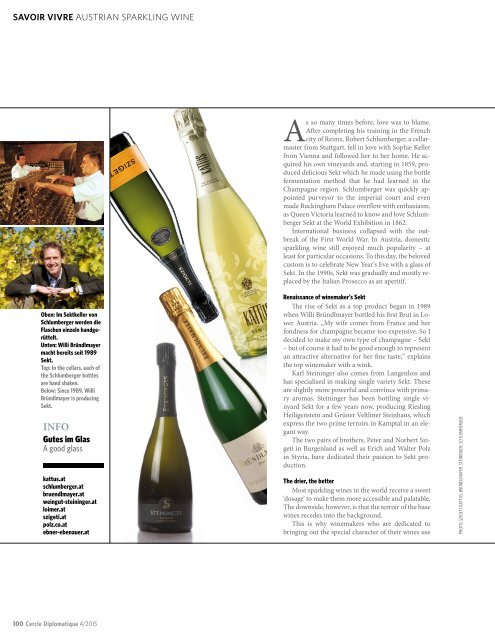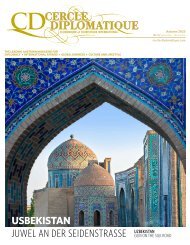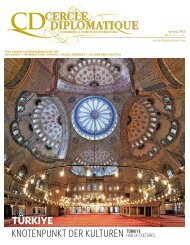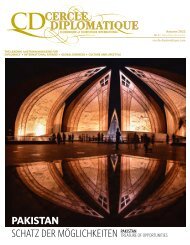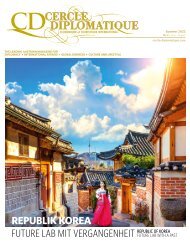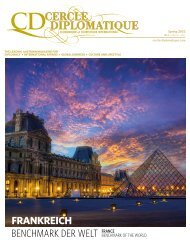CERCLE DIPLOMATIQUE - issue 04/2015
CD is an independent and impartial magazine and is the medium of communication between foreign representatives of international and UN-organisations based in Vienna and the Austrian political classes, business, culture and tourism. CD features up-to-date information about and for the diplomatic corps, international organisations, society, politics, business, tourism, fashion and culture. Furthermore CD introduces the new ambassadors in Austria and informs about designations, awards and top-events. Interviews with leading personalities, country reports from all over the world and the presentation of Austria as a host country complement the wide range oft he magazine.
CD is an independent and impartial magazine and is the medium of communication between foreign representatives of international and UN-organisations based in Vienna and the Austrian political classes, business, culture and tourism. CD features up-to-date information about and for the diplomatic corps, international organisations, society, politics, business, tourism, fashion and culture. Furthermore CD introduces the new ambassadors in Austria and informs about designations, awards and top-events. Interviews with leading personalities, country reports from all over the world and the presentation of Austria as a host country complement the wide range oft he magazine.
You also want an ePaper? Increase the reach of your titles
YUMPU automatically turns print PDFs into web optimized ePapers that Google loves.
SAVOIR VIVRE AUSTRIAN SPARKLING WINE<br />
Herkunft bürgt für Qualität | The origin stands for quality<br />
Oben: Im Sektkeller von<br />
Schlumberger werden die<br />
Flaschen einzeln handgerüttelt.<br />
Unten: Willi Bründlmayer<br />
macht bereits seit 1989<br />
Sekt.<br />
Top: In the cellars, each of<br />
the Schlumberger bottles<br />
are hand shaken.<br />
Below: Since 1989, Willi<br />
Bründlmayer is producing<br />
Sekt.<br />
INFO<br />
Gutes im Glas<br />
A good glass<br />
kattus.at<br />
schlumberger.at<br />
bruendlmayer.at<br />
weingut-steininger.at<br />
loimer.at<br />
szigeti.at<br />
polz.co.at<br />
ebner-ebenauer.at<br />
As so many times before, love was to blame.<br />
After completing his training in the French<br />
city of Reims, Robert Schlumberger, a cellarmaster<br />
from Stuttgart, fell in love with Sophie Keller<br />
from Vienna and followed her to her home. He acquired<br />
his own vineyards and, starting in 1859, produced<br />
delicious Sekt which he made using the bottle<br />
fermentation method that he had learned in the<br />
Champagne region. Schlumberger was quickly appointed<br />
purveyor to the imperial court and even<br />
made Buckingham Palace overflow with enthusiasm,<br />
as Queen Victoria learned to know and love Schlumberger<br />
Sekt at the World Exhibition in 1862.<br />
International business collapsed with the outbreak<br />
of the First World War. In Austria, domestic<br />
sparkling wine still enjoyed much popularity – at<br />
least for particular occasions. To this day, the beloved<br />
custom is to celebrate New Year‘s Eve with a glass of<br />
Sekt. In the 1990s, Sekt was gradually and mostly replaced<br />
by the Italian Prosecco as an aperitif.<br />
Renaissance of winemaker’s Sekt<br />
The rise of Sekt as a top product began in 1989<br />
when Willi Bründlmayer bottled his first Brut in Lower<br />
Austria. „My wife comes from France and her<br />
fondness for champagne became too expensive. So I<br />
decided to make my own type of champagne – Sekt<br />
– but of course it had to be good enough to represent<br />
an attractive alternative for her fine taste,“ explains<br />
the top winemaker with a wink.<br />
Karl Steininger also comes from Langenlois and<br />
has specialised in making single variety Sekt. These<br />
are slightly more powerful and convince with primary<br />
aromas. Steininger has been bottling single vinyard<br />
Sekt for a few years now, producing Riesling<br />
Heiligenstein and Grüner Veltliner Steinhaus, which<br />
express the two prime terroirs in Kamptal in an elegant<br />
way.<br />
The two pairs of brothers, Peter and Norbert Szigeti<br />
in Burgenland as well as Erich and Walter Polz<br />
in Styria, have dedicated their passion to Sekt production.<br />
The drier, the better<br />
Most sparkling wines in the world receive a sweet<br />
‘dosage’ to make them more accessible and palatable.<br />
The downside, however, is that the terroir of the base<br />
wines recedes into the background.<br />
This is why winemakers who are dedicated to<br />
bringing out the special character of their wines use<br />
PHOTO: SZIGETI, KATTUS, BRÜNDLMAYER, STEININGER, SCHLUMBERGER<br />
the lowest possible dosage. If it is dispensed with entirely,<br />
one then speaks of an „Ultra“ or „Extra Brut“<br />
Sekt. Both Bründlmayer and since recently Fred Loimer<br />
(Langenlois) have such extra dry Sekt in their<br />
selection.<br />
An extra long ripening period is used for the<br />
Blanc de Blancs from the Ebner-Ebenauer estate. „In<br />
2006, we started to develop our Chardonnay as a<br />
sparkling wine. When we tasted it for the first time<br />
nine months later, we were disappointed. Two years<br />
later it was ok, in its fifth year terrific,“ says Marion<br />
Ebner-Ebenauer. Their patience was rewarded with<br />
winning the 2008 vintage category at this year’s<br />
GaultMillau sparkling wine tasting.<br />
Bubbles with an economic factor<br />
From the Day of Austrian Sekt (traditionally in<br />
the third week of October) until the end of the year,<br />
around 12 million bottles Sekt are consumed. This is<br />
usually 45 per cent of the total annual amount. The<br />
Austrian Sekt Committee now is taking care of better<br />
visibility and presence in Austria as well as all over<br />
the world.<br />
Ball<br />
~ der ~<br />
Wiener<br />
Sängerknaben<br />
Samstag,<br />
16. Jänner 2016<br />
Kursalon Hübner<br />
Nach einem zwei Jahre währenden Prozess der Qualitätsjustierung durch das Österreichische<br />
Sektkomitee gibt es nun eine Definition: die Qualitätspyramide für österreichischen Qualitätssekt.<br />
Klassik, Reserve und Große Reserve kennzeichnen die drei Stufen der neuen Einteilung.<br />
Alle Produkte der Qualitätspyramide sind geschützten Ursprungs. Die Basiskategorie Klassik<br />
garantiert vor allem die Herkunft der Trauben aus einem österreichischen Bundesland. Ab der<br />
zweiten Stufe, Reserve, muss ausschließlich nach der traditionellen Methode (Flaschengärung)<br />
produziert werden. Die Trauben müssen hier in einem generischen Weinbaugebiet (Bundesland)<br />
gelesen und gepresst werden. Für die Große Reserve dürfen die Trauben nur in einer einzigen<br />
Weinbaugemeinde gelesen und ebenfalls mit Flaschengärung nach dieser bezeichnet werden<br />
(wie Poysdorf, Langenlois, Gols, Gamlitz), wobei Lagenbezeichnungen möglich sind. Die drei<br />
Kategorien unterscheiden sich zudem durch die Reifedauer auf der Hefe von 9, 18 und<br />
36 Monaten. Bester Sekt aus Österreich ist eben auch eine Sache der Geduld.<br />
After a two-year process of quality adjustment by the Austrian Sekt Committee, there is now an<br />
agreement: the quality pyramid for Austrian quality Sekt. Classic, Reserve and Grand Reserve<br />
now characterise the three stages of the new classification. All products in the quality pyramid<br />
are from protected origin. The base category Classic mainly guarantees the origin of the grapes<br />
from a federal province. From the second stage onward, Reserve, production must exclusively<br />
be carried out using the traditional method (bottle fermentation). The grapes must be<br />
harvested and pressed in a generic wine-growing region (federal province). For the Grand<br />
Reserve, the grapes are only allowed to be harvested in a single wine-growing community and,<br />
using bottle-fermentation, are to refer to their community (such as Poysdorf, Langenlois, Gols,<br />
Gamlitz), whereas vineyard names are also allowed. The three categories also differ by the<br />
ripening period with yeast for 9, 18 and 36 months. After all, the best Austrian Sekt is also a<br />
matter of patience.<br />
oesterreichsekt.at<br />
Foto: lukasbeck.com<br />
Gastland 2016:<br />
Bosnien und Herzegowina<br />
Karten- und Tischreservierung ab sofort unter:<br />
01 347 80 80<br />
http://ball.wsk.at<br />
100 Cercle Diplomatique 4/<strong>2015</strong>


